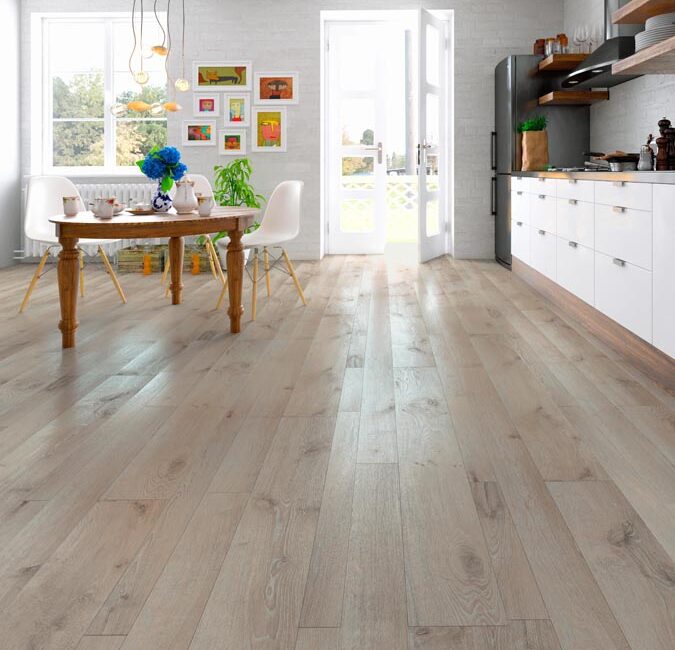
When you step into a home or office, the first thing that sets the mood of the space is often the flooring. Floors provide more than just a surface to walk on—they influence comfort, style, durability, and the overall atmosphere of a room. Choosing the right flooring is one of the most impactful decisions in any renovation or new build.
In this guide, we’ll explore different types of flooring, their benefits, drawbacks, costs, and maintenance tips. Whether you’re aiming for luxury, practicality, or sustainability, this article will help you make the perfect choice.
Why Flooring Is So Important
Flooring plays a central role in the design and function of any interior:
- Design Foundation: Floors set the tone for your interior style—whether it’s rustic wood, modern tile, or cozy carpet.
- Durability: The right flooring material withstands daily wear and tear for decades.
- Comfort: Some materials like cork and carpet provide softness, while others like tile are sleek and cool.
- Value: Quality flooring increases home resale value.
- Functionality: Each room has unique flooring needs—for example, kitchens require waterproof options, while bedrooms favor warmth 實木複合地板.
Popular Types of Flooring
Here’s a breakdown of the most widely used flooring options available today:
1. Hardwood Flooring
Classic and timeless, hardwood adds elegance and warmth.
- Pros: Long-lasting, can be refinished, boosts home value.
- Cons: Expensive, prone to scratches, sensitive to moisture.
- Best For: Living rooms, dining rooms, bedrooms.
2. Engineered Wood
A cost-effective alternative to solid hardwood.
- Pros: More affordable, resistant to moisture, real-wood appearance.
- Cons: Limited refinishing ability.
- Best For: Areas where humidity is a concern.
3. Laminate Flooring
An economical option that mimics wood, tile, or stone.
- Pros: Scratch-resistant, budget-friendly, DIY-friendly installation.
- Cons: Susceptible to water damage, can’t be refinished.
- Best For: Living rooms, offices, hallways.
4. Vinyl Flooring
Available as planks, tiles, or sheets, vinyl is versatile and waterproof.
- Pros: Affordable, water-resistant, low maintenance.
- Cons: Can dent or fade, lower resale value.
- Best For: Bathrooms, kitchens, laundry rooms.
5. Tile Flooring
Durable and available in countless designs.
- Pros: Water-resistant, long-lasting, easy to clean.
- Cons: Cold and hard underfoot, grout requires upkeep.
- Best For: Kitchens, bathrooms, entryways.
6. Carpet Flooring
Soft and cozy, carpet remains popular for comfort and warmth.
- Pros: Comfortable, noise-reducing, budget-friendly options available.
- Cons: Stains easily, requires frequent cleaning, not ideal for allergies.
- Best For: Bedrooms, family rooms, basements.
7. Bamboo Flooring
A sustainable choice that resembles hardwood.
- Pros: Eco-friendly, attractive, durable.
- Cons: Quality varies, can swell with humidity.
- Best For: Eco-conscious homeowners.
8. Cork Flooring
Known for its unique softness and eco-friendly production.
- Pros: Cushioned feel, natural insulation, sustainable.
- Cons: Can fade in sunlight, prone to dents.
- Best For: Living areas, playrooms, and home gyms.
Flooring by Room
Choosing flooring isn’t only about the material—it’s also about where it will be used.
- Living Room: Hardwood, laminate, or carpet create comfort and warmth.
- Kitchen: Vinyl and tile are best due to water and stain resistance.
- Bathroom: Waterproof flooring like vinyl, tile, or stone.
- Bedroom: Carpet or hardwood for warmth and relaxation.
- Office: Laminate or engineered wood for durability and professional appeal.
Cost of Flooring Materials
Budget is often the biggest factor in flooring decisions. Here’s an average cost breakdown:
- Carpet: $2–$10 per sq. ft.
- Laminate: $2–$7 per sq. ft.
- Vinyl: $2–$8 per sq. ft.
- Tile: $5–$15 per sq. ft.
- Hardwood: $8–$20 per sq. ft.
- Bamboo/Cork: $5–$12 per sq. ft.
Installation costs vary depending on complexity, with tile and hardwood typically being more expensive to install.
Flooring Installation: DIY vs Professional
- DIY-Friendly: Laminate, vinyl planks, and some engineered wood options are great for do-it-yourself projects.
- Professional Required: Hardwood, tile, and carpet often need skilled installers to ensure durability and a perfect finish.
Hiring a professional may add to costs but guarantees a polished and long-lasting result.
Flooring Maintenance Tips
Each flooring type requires different levels of care:
- Hardwood: Sweep often, avoid water spills, refinish every few years.
- Laminate: Clean with a damp mop, avoid excess water.
- Vinyl: Use gentle cleaners, avoid dragging furniture.
- Tile: Clean grout lines regularly, reseal natural stone.
- Carpet: Vacuum often, steam clean annually, treat stains quickly.
Flooring Trends in 2025
Interior design evolves, and flooring is no exception. Here are the latest trends:
- Luxury Vinyl Plank (LVP): Affordable, stylish, and waterproof.
- Wide Plank Hardwood: Minimal seams, modern and rustic look.
- Eco-Friendly Materials: Bamboo and cork gaining traction.
- Textured Surfaces: Wire-brushed and hand-scraped wood.
- Patterned Tiles: Bold, geometric, and Moroccan-inspired designs.
Final Thoughts
Flooring is one of the most important design and functional elements in any home or office. It sets the mood, provides durability, and enhances the overall experience of a space. Whether you choose classic hardwood, cost-friendly laminate, or practical vinyl, the right flooring depends on your lifestyle, budget, and personal style.